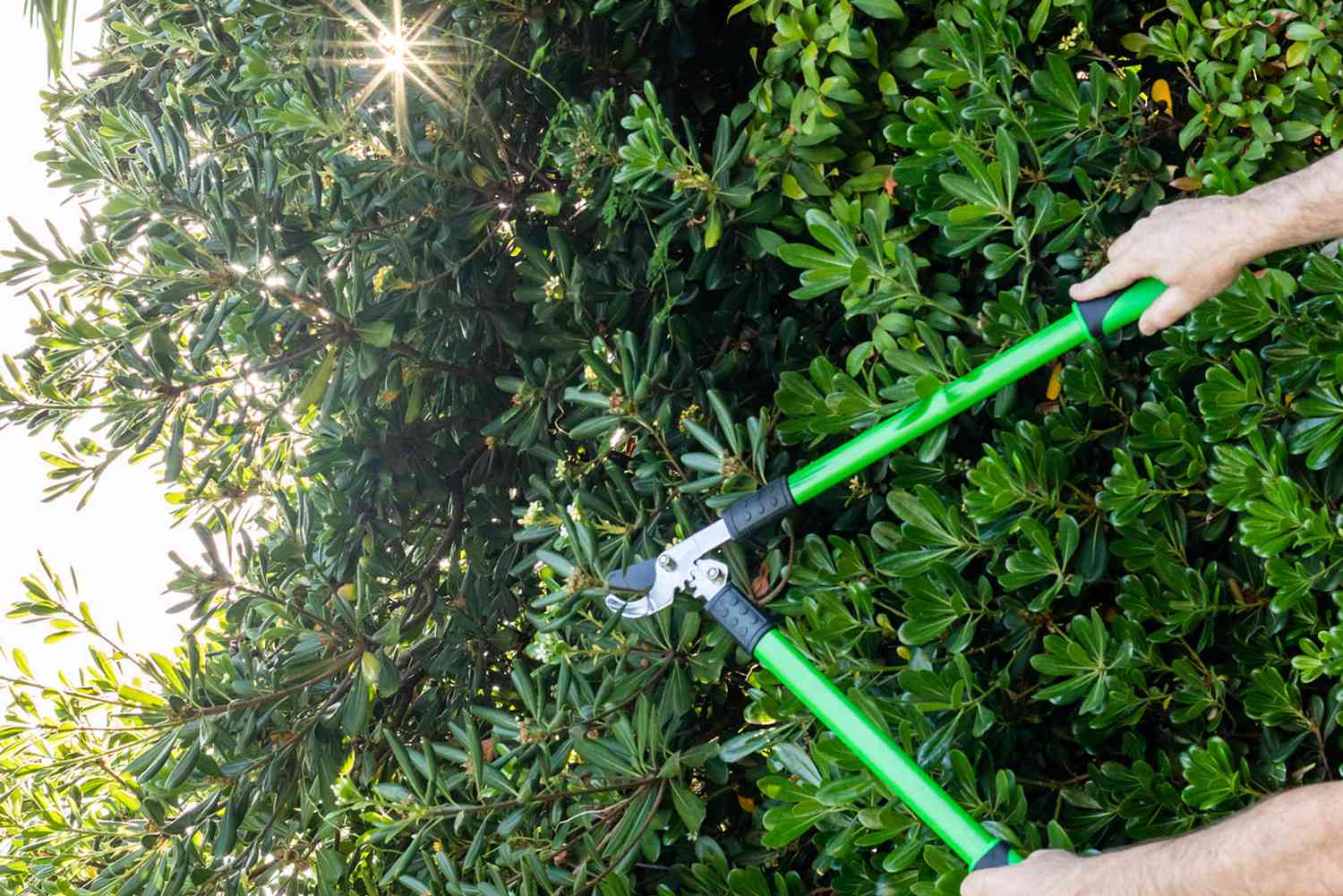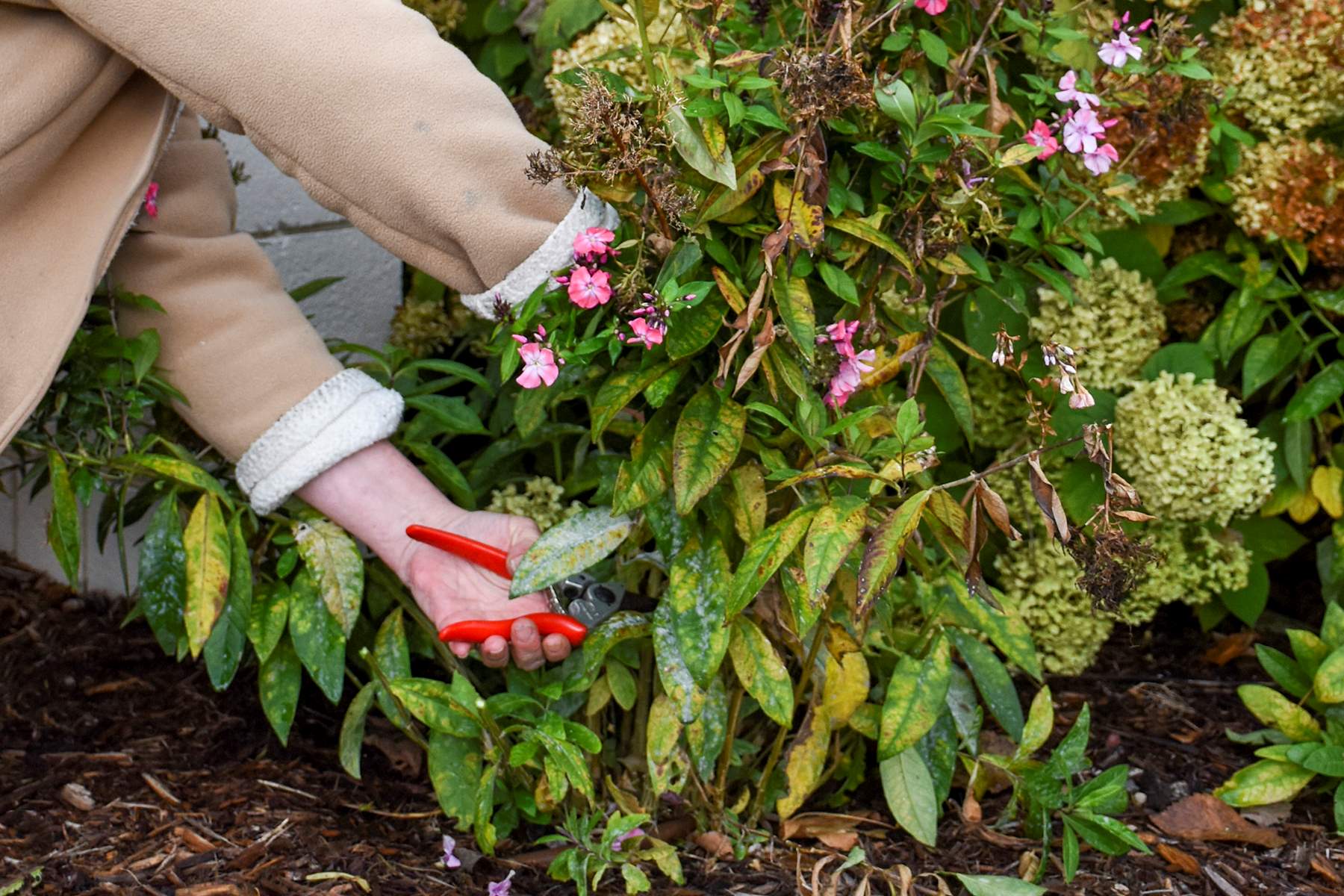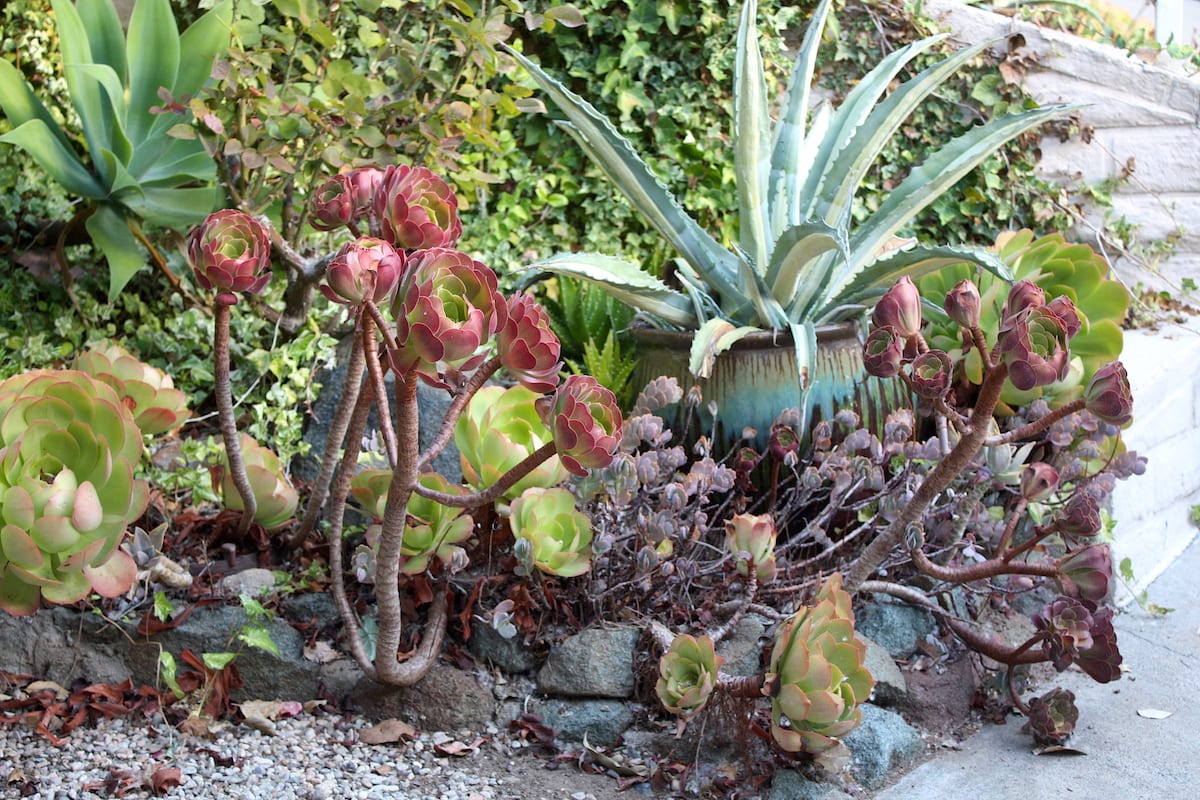Home>Gardening Techniques>Plant Care>How To Cut Back Overgrown Evergreen Shrubs


Plant Care
How To Cut Back Overgrown Evergreen Shrubs
Modified: January 22, 2024
Learn how to properly care for your overgrown evergreen shrubs with our step-by-step guide on plant care. Cut back and maintain your shrubs for a healthy and beautiful garden.
(Many of the links in this article redirect to a specific reviewed product. Your purchase of these products through affiliate links helps to generate commission for Chicagolandgardening.com, at no extra cost. Learn more)
Table of Contents
- Introduction
- Assessing the Overgrown Evergreen Shrubs
- Gathering the Necessary Tools and Safety Equipment
- Pruning Techniques for Overgrown Evergreen Shrubs
- Pruning Guidelines for Different Types of Evergreen Shrubs
- Addressing Common Issues while Pruning Overgrown Evergreen Shrubs
- Cleaning Up and Maintaining Pruned Evergreen Shrubs
- Conclusion
Introduction
Welcome to the world of plant care! If you’re a plant enthusiast, you know that keeping your green companions healthy and thriving requires regular maintenance. One aspect of plant care that often gets overlooked is the pruning of overgrown evergreen shrubs. These beautiful plants can add structure, color, and texture to your garden, but if left unattended, they can become unruly and hinder their own growth.
Overgrown evergreen shrubs not only detract from the overall aesthetic of your garden but can also lead to decreased air circulation and increased susceptibility to pests and diseases. Thankfully, with the right knowledge and tools, you can give your shrubs the trim they need to flourish.
In this article, we will guide you through the process of cutting back overgrown evergreen shrubs, from assessing their condition to choosing the correct pruning techniques. We’ll discuss the different types of evergreen shrubs and provide specific guidelines for each. Additionally, we’ll address common issues that may arise during the pruning process and offer tips for maintaining your pruned evergreen shrubs.
Whether you are a seasoned gardener or just starting your plant care journey, this article will equip you with the knowledge and confidence to tackle overgrown evergreen shrubs. So, put on your gardening gloves and let’s dive in!
Assessing the Overgrown Evergreen Shrubs
Before diving into the pruning process, it’s essential to assess the condition of your overgrown evergreen shrubs. This step will help you determine the extent of pruning needed and ensure the overall health and vitality of the plants.
Begin by observing the shrubs from a distance. Look for signs of overcrowding, wilting or yellowing foliage, branches crossing or rubbing against each other, or a general lack of shape and structure. These are all indicators of overgrowth and a need for pruning.
Next, get up close and personal with the shrubs. Examine the branches for any signs of damage or disease, such as dead or decaying wood, fungal growth, or pest infestations. Take note of any areas that appear weak or congested.
Consider the overall health of the shrubs. Are they growing vigorously, or do they seem stagnant? Are there any areas of dense foliage that may be blocking sunlight from reaching the inner branches?
Assessing the size and shape of the shrubs is also important. Are they encroaching on nearby plants or structures? Are they impeding walkways or obstructing views? Understanding the desired dimensions and form of the shrubs will guide your pruning decisions.
Based on your assessment, you can determine whether a light pruning or a more drastic rejuvenation pruning is needed. Light pruning involves removing specific branches or sections to improve shape and maintain overall plant health. Rejuvenation pruning, on the other hand, involves more aggressive cutting back to stimulate new growth and restore the shrub’s vitality.
Remember, it’s important not to remove more than one-third of the plant’s foliage at a time, as this can shock the shrub and inhibit its ability to recover. If rejuvenation pruning is necessary, it may need to be done in stages over multiple seasons.
By thoroughly assessing your overgrown evergreen shrubs, you’ll be able to develop a targeted pruning plan that addresses their specific needs. In the next section, we’ll discuss the tools and safety equipment required to carry out the pruning process effectively.
Gathering the Necessary Tools and Safety Equipment
Once you have assessed your overgrown evergreen shrubs and determined the pruning approach, it’s time to gather the necessary tools and safety equipment. Having the right tools on hand will ensure a smooth and efficient pruning process.
Here are some essential tools for pruning overgrown evergreen shrubs:
- Pruning shears: These handheld tools with sharp, bypass blades are ideal for cutting small branches and stems. Look for shears with a comfortable grip and a cutting capacity that suits the size of your shrubs.
- Loppers: Loppers have long handles and larger, more robust cutting blades. They are useful for trimming thicker branches that are out of reach of pruning shears. Consider getting both bypass loppers for green wood and anvil loppers for dead wood.
- Pruning saw: A pruning saw with a curved or straight blade will come in handy for cutting through larger branches. It provides more control and precision than loppers or shears.
- Pole pruner: If your evergreen shrubs have tall or hard-to-reach branches, a pole pruner with a saw or shears attachment can be invaluable. It allows you to extend your reach while maintaining control.
- Gloves: Choose a pair of sturdy gardening gloves that provide protection against thorns, splinters, and other potential hazards. Opt for gloves with a snug fit and excellent grip for precise handling of the pruning tools.
- Safety goggles: Protect your eyes from flying debris and sharp branches with a pair of safety goggles or glasses. Look for ones that fit comfortably and have clear lenses.
- Pruning sealant: While not necessary, applying a pruning sealant to large cuts or wounds can help prevent diseases and promote healing. Choose a product specifically designed for sealing tree and shrub wounds.
Before you begin pruning, ensure your tools are clean and properly maintained. Dull or dirty blades can make pruning more difficult and can potentially damage the plants. Clean your tools after each use, and periodically sharpen them to maintain their effectiveness.
Don’t forget about safety! Work gloves, safety goggles, and sturdy footwear are all essential to protect yourself during the pruning process. If you need to use a ladder, choose one that is stable and secure. Always inform someone that you’ll be using a ladder and have them nearby for assistance if needed.
By gathering the necessary tools and safety equipment before starting the pruning process, you’ll be well-prepared to tackle the overgrown evergreen shrubs and achieve the desired results. In the next section, we’ll explore various pruning techniques you can employ for these shrubs.
Pruning Techniques for Overgrown Evergreen Shrubs
Pruning overgrown evergreen shrubs requires careful consideration of the specific pruning techniques to employ. The goal is to maintain the health and shape of the shrubs while promoting new growth and rejuvenation.
Here are some pruning techniques to consider when tackling overgrown evergreen shrubs:
- Selective pruning: This technique involves removing specific branches or sections of the shrub to improve its shape and structure. Begin by targeting any dead, damaged, or diseased branches. Then, remove any crossing or rubbing branches that may obstruct airflow. Finally, selectively prune branches that are growing in undesirable directions or encroaching on other plants or structures.
- Thinning: Thinning involves selectively removing branches to reduce the density of the shrub’s foliage. This technique allows for better air circulation and penetration of sunlight, promoting the growth of new, healthier branches. When thinning, aim to remove no more than one-third of the branches, focusing on the inner areas of the shrub where light may be limited.
- Heading back: Heading back is a technique used to reduce the overall size of the shrub by cutting back the branches to a specific point. This technique encourages new growth and helps maintain the desired shape and size. When heading back, make cuts just above a bud or lateral branch to promote branching and prevent unsightly stubs.
- Rejuvenation pruning: Rejuvenation pruning is a more drastic technique used for severely overgrown shrubs. It involves cutting the entire shrub back to a few inches above the ground. While it may seem drastic, this technique stimulates new growth and rejuvenates the shrub. Rejuvenation pruning is best done during the dormant season, typically in late winter or early spring.
Regardless of the pruning technique you choose, it’s important to make clean and precise cuts. Use sharp pruning tools and avoid tearing or ripping the branches. Clean cuts promote faster healing and reduce the risk of disease or pest infestation.
As you prune, step back periodically to assess the shape and balance of the shrub. Ensure that you are maintaining the desired form while promoting healthy growth. Don’t be afraid to take your time and make adjustments as needed.
Remember, every shrub is unique, and the specific pruning techniques may vary depending on the type and individual characteristics of the shrub. In the next section, we’ll provide specific guidelines for pruning different types of evergreen shrubs.
Pruning Guidelines for Different Types of Evergreen Shrubs
When it comes to pruning different types of evergreen shrubs, it’s essential to understand their specific growth habits and requirements. Different shrub species may have different pruning preferences, and following specific guidelines will help you achieve the best results.
Here are some general pruning guidelines for common types of evergreen shrubs:
- Boxwoods (Buxus spp.): Boxwoods are dense, compact shrubs often used for hedges or topiaries. They can be pruned in late spring or early summer after the new growth has emerged. To maintain their shape, lightly trim the outer foliage, avoiding cutting into the older wood. Avoid pruning too late in the growing season, as it may inhibit new growth before winter.
- Hollies (Ilex spp.): Hollies are versatile evergreen shrubs with glossy foliage and vibrant berries. They tolerate pruning well. Prune in late winter or early spring before new growth appears. Remove any dead or damaged branches and shape the shrub as desired. Remember to wear gloves when handling hollies, as some species have sharp thorns.
- Junipers (Juniperus spp.): Junipers come in various sizes and forms, from ground covers to tall shrubs. Prune junipers in early spring or late winter before new growth begins. Use selective pruning to remove any dead or weak branches. Lightly shear the outer foliage to maintain the desired shape and density. Avoid cutting into the bare wood, as junipers have limited ability to regenerate from older branches.
- Yews (Taxus spp.): Yews are slow-growing evergreen shrubs with dark green foliage. They respond well to pruning and can be shaped into hedges or topiaries. Prune yews in early spring before the new growth appears. Use selective pruning to maintain the shape and remove any dead or damaged branches. Avoid excessive pruning, as yews may take several years to regenerate from old wood.
- Arborvitae (Thuja spp.): Arborvitae shrubs have a conical or pyramidal shape and make excellent privacy screens. Prune arborvitae in late spring or early summer after the new growth has emerged. Remove any dead or diseased branches, as well as any crossing or rubbing branches. Shear the outer foliage lightly to maintain the desired shape and density.
Keep in mind these are general guidelines, and it’s always beneficial to research specific pruning recommendations for the particular variety of evergreen shrub you have. Some species may have specific preferences or requirements when it comes to pruning. Understanding the growth habits and characteristics of your specific shrubs will help you make informed pruning decisions.
By following these pruning guidelines for different types of evergreen shrubs, you can ensure healthy growth, maintain their desired shape, and maximize their beauty in your garden. In the next section, we’ll address common issues that may arise while pruning overgrown evergreen shrubs.
Addressing Common Issues while Pruning Overgrown Evergreen Shrubs
While pruning overgrown evergreen shrubs can bring numerous benefits, it’s important to be aware of the common issues that may arise during the process. Understanding and addressing these issues will help you achieve optimal results and maintain the health of your shrubs.
Here are some common issues you may encounter while pruning overgrown evergreen shrubs and how to address them:
- Weak or congested growth: Overgrown shrubs may have areas of weak or congested growth with dense foliage that lacks airflow and sunlight. To address this issue, use the thinning technique to selectively remove branches and improve air circulation. Focus on cutting back branches growing towards the center of the shrub, allowing light to reach the inner areas and promoting new, healthier growth.
- Unruly or misshapen shrubs: Over time, evergreen shrubs can lose their desired shape and become unruly. To address this, use selective pruning to remove branches that are growing in undesirable directions or encroaching on other plants or structures. Take your time and step back periodically to assess the shape and balance of the shrub, making adjustments as needed.
- Large cuts or wounds: When pruning overgrown shrubs, you may need to make large cuts or remove substantial branches. To ensure proper healing and minimize the risk of disease or pests, make clean cuts close to the branch collar, which is the swollen area where the branch meets the trunk. Avoid leaving stubs, as they can be more prone to decay.
- Unsightly stubs: Careless pruning can result in unsightly stubs that take longer to heal and may affect the shrub’s appearance. To avoid this, make cuts just above a bud or lateral branch to encourage branching and camouflaging of the cut. Consider the natural growth pattern of the shrub and prune accordingly to maintain a more natural and aesthetically pleasing shape.
- Timing and the risk of regrowth: Pruning overgrown evergreen shrubs, especially with rejuvenation pruning, can trigger vigorous regrowth. To minimize the risk of excessive regrowth, it’s important to time your pruning correctly. In general, perform rejuvenation pruning during the dormant season, when the shrub is at its least active. This gives the shrub time to recover and redirect its energy towards new growth in the following growing season.
While addressing these common issues, it’s important to stay patient and give your shrubs time to recover and rejuvenate. Pruning is a process that takes time, and it may require multiple pruning sessions to achieve the desired results.
By being mindful of these common issues and taking the necessary steps to address them, you can ensure that your pruning efforts result in healthier, more attractive evergreen shrubs. In the next section, we’ll discuss the importance of cleaning up and maintaining pruned evergreen shrubs.
Cleaning Up and Maintaining Pruned Evergreen Shrubs
After successfully pruning your overgrown evergreen shrubs, it’s important to properly clean up and implement maintenance practices to ensure their continued health and beauty. Cleaning up and maintaining pruned shrubs will help them recover from the pruning process and promote new growth.
Here are some key steps to follow for cleaning up and maintaining pruned evergreen shrubs:
- Remove pruned branches and debris: Start by removing the pruned branches and any debris that has accumulated around the shrubs. This will improve airflow and prevent potential pest or disease issues.
- Dispose of branches responsibly: Dispose of pruned branches responsibly by composting them, using them as mulch, or arranging for proper disposal. Avoid leaving pruned branches near the shrubs, as they can create a breeding ground for pests or disease.
- Water thoroughly: After pruning, water the shrubs thoroughly to help them recover from the stress of pruning and stimulate new growth. Provide enough water to saturate the soil around the shrubs, ensuring proper moisture penetration.
- Apply compost or mulch: Apply a layer of compost or mulch around the base of the shrubs to help retain moisture, suppress weeds, and provide nutrient-rich organic matter. Avoid piling mulch directly against the stems to prevent rot and fungal issues.
- Monitor for pests and diseases: Keep a close eye on the pruned evergreen shrubs for any signs of pests or diseases. Pruning can create wounds that make the shrubs more susceptible to infestations. If you notice any issues, take appropriate action such as using organic pest control methods or seeking professional advice if needed.
- Maintain regular pruning: To keep your evergreen shrubs in optimal condition, maintain a regular pruning schedule. Lightly prune them as needed to remove any dead or diseased branches and maintain their shape and size. Regular pruning will also help prevent the shrubs from becoming overgrown again.
- Provide ongoing care: In addition to pruning, provide ongoing care to your evergreen shrubs. This includes proper irrigation, regular fertilization, and monitoring for any signs of stress or nutrient deficiencies. A well-maintained environment will ensure the health and vitality of your pruned shrubs.
By following these cleaning up and maintenance practices, you will give your pruned evergreen shrubs the best chance to recover, thrive, and continue to enhance the beauty of your garden for years to come.
Now that you have learned the process of cutting back overgrown evergreen shrubs and the importance of cleaning up and maintenance, you are equipped with the knowledge to tackle this task. With patience, care, and regular attention, your evergreen shrubs will flourish and bring joy to your garden.
Conclusion
Cutting back overgrown evergreen shrubs may seem like a daunting task, but armed with the right knowledge and tools, it becomes an achievable and rewarding endeavor. By assessing the condition of the shrubs, gathering the necessary tools and safety equipment, understanding pruning techniques, and following specific guidelines for different types of evergreen shrubs, you can successfully rejuvenate and maintain the health of your shrubs.
Throughout the pruning process, it’s important to address common issues, such as weak growth, unruly shape, large wounds, unsightly stubs, and timing of pruning to minimize regrowth. By understanding and mitigating these issues, you’ll ensure optimal results and set your shrubs up for continued health and vitality.
Once you’ve completed the pruning process, don’t forget about the importance of cleaning up and maintaining your pruned evergreen shrubs. Properly disposing of pruned branches, watering, applying compost or mulch, monitoring for pests and diseases, and maintaining a regular pruning schedule are all crucial for the continued care and well-being of your shrubs.
Remember, pruning is a process that requires patience, care, and ongoing attention. With time and consistency, your evergreen shrubs will not only regain their shape and health but also continue to beautify your garden for years to come.
So put on your gardening gloves, grab your pruning tools, and embark on the journey of cutting back your overgrown evergreen shrubs. Enjoy the satisfaction of transforming your plants and witnessing their renewed vitality in your garden. Happy pruning!









